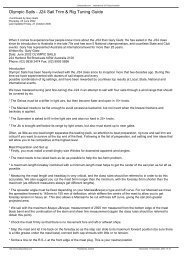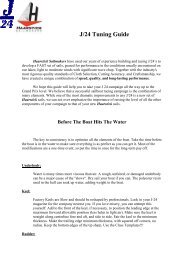NORTH SAILS Soling Tune.pdf - Sailmaker.org
NORTH SAILS Soling Tune.pdf - Sailmaker.org
NORTH SAILS Soling Tune.pdf - Sailmaker.org
Create successful ePaper yourself
Turn your PDF publications into a flip-book with our unique Google optimized e-Paper software.
<strong>NORTH</strong> <strong>SAILS</strong><br />
SOLING ONE DESIGN TUNE<br />
MAST RAKE AND SHROUD TENSION<br />
Most boats have an adjustable forestay which allows the crew to change the mast rake for different wind<br />
velocities. Our rake is checked by measuring the amount of forestay that exceeds the mast length. Hold<br />
your forestay along the front of the mast and simply mark the forestay at the point where the bottom of<br />
the mast would be. We check our rake by measuring the distance from this mark to where the forestay<br />
intersects with the deck. We suggest you set the rake at 29" inches. After the rake is set, It is possible to<br />
make marks on the mainsheet, backstay, and jib clew heights for different wind and wave conditions. In<br />
light wind conditions (under 7 knots) we suggest a 30" inches rake. This will increase " feel " and make<br />
the boat easier to steer. Remember that every time you change the rake, all these control marks have to<br />
be changed.<br />
SHROUDS TENSION<br />
Our shroud tension is measured with the shroud in the forward position, and the backstay on, so the<br />
headstay is snug at 29" inches of mast rake. Uppers should be at 700 lbs. at all conditions.<br />
Lowers should be set so the mast (when sailing), have 1 1/2" inches (one and half inches) of sag at the<br />
spreaders, for light air; increasing tension to 500 lbs. at 18 knots of wind.<br />
NOTES:<br />
• Please remember that the more upper shroud tension you have, the more pre-bend you will<br />
have.<br />
• If you have a soft mast, and or the mainsail looks a bit flat, you may need less upper tension.<br />
SHROUD POSITION - We have five settings for the fore and aft movement of the shroud position at the<br />
deck. The total travel is 12" inches.<br />
TRACK POSITION WIND WIND RANGE<br />
#1 full forward Light Air 0-7 Knots<br />
#2 Light to Medium 7-10<br />
#3 middle track Medium 10-16<br />
#4 Fresh 16-20<br />
#5 full aft Strong 20+<br />
Be careful not to de-power the boat too quickly, especially with waves.
SAIL COMBINATIONS<br />
We recommend the following sail combinations:<br />
0- 14 knots ES-12 Main and V-1 plus Jib<br />
8- 20 knots ES-12 Main and V-1 Turbo Jib<br />
18 knots and above ES-12 Main and A-1 Jib<br />
BACKSTAY<br />
There are two things that the backstay does. Controls the fullness in the mainsail and also the forestay<br />
sag. This is probably the most important adjustment in the <strong>Soling</strong>. The more backstay tension, the flatter<br />
the main, and the less forestay sag results in a flatter jib. I have my backstay marked on every inch, so<br />
is easy to repeat fast settings and have the boat ready, quickly after mark rounding. Our mainsail is<br />
designed so that the mast bend and forestay sag are matched for the conditions.<br />
MAINSHEET TENSION<br />
The mainsheet controls the top part of the mainsail. The quickest and most accurate way to trim the<br />
mainsail is to watch the angle of the top batten. Sighting from under the boom, the top batten should be<br />
parallel to the boom most of the time, if not in overpowered conditions. In flat water, the top batten can<br />
point five degrees to weather of the centerline, and when overpowered, it should open from centerline<br />
until helm balances.<br />
BOOM VANG<br />
The rule of thumb, is to have the vang adjusted for the downwind legs, so the top batten is parallel to<br />
the boom.<br />
This control is also important when close hauled, by helping control the forestay sag and making the jib<br />
either more or less powerful. In smooth water, the vang should not be used, so the forestay is as<br />
straight as possible. In choppy waters, boom vang should be used, and by experimenting you will be able<br />
to find the perfect tension, which is normally when helm is almost neutral.<br />
MAINSAIL TRAVELER<br />
The boom should be about 4 to 5 inches above centerline until both crews are over the side and boat is<br />
overpowered. At this point traveler should be placed on the centerline (not very often the traveler should<br />
be placed below centerline).<br />
JIB TRAVELER<br />
A good starting position is 10 to 11 inches athwart ship centerline. In heavy air, it should go outboard 2<br />
to 4 inches (20 knots and above), this will help stop the back wind on the mainsail under heavy breezes.
CLEWBOARD POSITION<br />
This will vary from boat to boat, but the third hole for the V-1 jib and the A-1 jib will be a good starting<br />
point. When it is light and crew is inside or not fully hiked, make the jib fuller down low, by going to a<br />
higher hole (or just by moving the whole jib up). When crew is fully hiked and the wind is stronger, make<br />
the foot flatter, by moving to a lower clew hole (or by moving the whole jib down). For full power<br />
conditions, the jib should luff evenly from top to bottom.<br />
LUFF TENSION<br />
All jibs should be set with minimum luff tension, just enough to take most of scallops out; DON'T OVER<br />
STRETCH. Too much tension moves the draft forward, which is very slow.<br />
OUTHAUL<br />
In light air the outhaul should be stretched to about 1 to 1 1/2" inches from maximum out. As the wind<br />
increases, pull the outhaul all the way out so the sail is perfectly flat right of the boom. In reaching, the<br />
outhaul should at maximum ease (about 3" inches).<br />
RUNNING AND REACHING WITH SPINNAKER<br />
A lot can be done in terms of speed when running and reaching, and if you are faster than the<br />
competition, that could be the necessary edge you need to win.<br />
Is a well know fact that, when sailing downwind, the fastest setting is by moving the mast as far forward<br />
as your backstay would allow.<br />
The other important controls are the pole fore & aft and up & down. For fore & aft adjustments try to<br />
have the luff of the spinnaker perpendicular right out of the pole.<br />
For up & down control, the pole should be adjusted so the clews are even height from the water

















